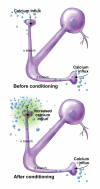Traces of Drosophila memory
- PMID: 21482352
- PMCID: PMC3374581
- DOI: 10.1016/j.neuron.2011.03.012
Traces of Drosophila memory
Abstract
Studies using functional cellular imaging of living flies have identified six memory traces that form in the olfactory nervous system after conditioning with odors. These traces occur in distinct nodes of the olfactory nervous system, form and disappear across different windows of time, and are detected in the imaged neurons as increased calcium influx or synaptic release in response to the conditioned odor. Three traces form at or near acquisition and coexist with short-term behavioral memory. One trace forms with a delay after learning and coexists with intermediate-term behavioral memory. Two traces form many hours after acquisition and coexist with long-term behavioral memory. The transient memory traces may support behavior across the time windows of their existence. The experimental approaches for dissecting memory formation in the fly, ranging from the molecular to the systems, make it an ideal system for elucidating the logic by which the nervous system organizes and stores different temporal forms of memory.
Copyright © 2011 Elsevier Inc. All rights reserved.
Figures









Similar articles
-
Olfactory memory traces in Drosophila.Prog Brain Res. 2008;169:293-304. doi: 10.1016/S0079-6123(07)00018-0. Prog Brain Res. 2008. PMID: 18394482 Free PMC article. Review.
-
Aversive Training Induces Both Presynaptic and Postsynaptic Suppression in Drosophila.J Neurosci. 2019 Nov 13;39(46):9164-9172. doi: 10.1523/JNEUROSCI.1420-19.2019. Epub 2019 Sep 26. J Neurosci. 2019. PMID: 31558620 Free PMC article.
-
A late-phase, long-term memory trace forms in the γ neurons of Drosophila mushroom bodies after olfactory classical conditioning.J Neurosci. 2010 Dec 8;30(49):16699-708. doi: 10.1523/JNEUROSCI.1882-10.2010. J Neurosci. 2010. PMID: 21148009 Free PMC article.
-
Insect olfactory memory in time and space.Curr Opin Neurobiol. 2006 Dec;16(6):679-85. doi: 10.1016/j.conb.2006.09.003. Epub 2006 Nov 3. Curr Opin Neurobiol. 2006. PMID: 17084613 Review.
-
Functional neuroanatomy of Drosophila olfactory memory formation.Learn Mem. 2014 Sep 15;21(10):519-26. doi: 10.1101/lm.034363.114. Print 2014 Oct. Learn Mem. 2014. PMID: 25225297 Free PMC article. Review.
Cited by
-
A genetic screen for olfactory habituation mutations in Drosophila: analysis of novel foraging alleles and an underlying neural circuit.PLoS One. 2012;7(12):e51684. doi: 10.1371/journal.pone.0051684. Epub 2012 Dec 17. PLoS One. 2012. PMID: 23284741 Free PMC article.
-
A Putative Biochemical Engram of Long-Term Memory.Curr Biol. 2016 Dec 5;26(23):3143-3156. doi: 10.1016/j.cub.2016.09.054. Epub 2016 Nov 3. Curr Biol. 2016. PMID: 27818176 Free PMC article.
-
Integration of the olfactory code across dendritic claws of single mushroom body neurons.Nat Neurosci. 2013 Dec;16(12):1821-9. doi: 10.1038/nn.3547. Epub 2013 Oct 20. Nat Neurosci. 2013. PMID: 24141312 Free PMC article.
-
Neural Circuits Underlying Behavioral Flexibility: Insights From Drosophila.Front Behav Neurosci. 2022 Jan 6;15:821680. doi: 10.3389/fnbeh.2021.821680. eCollection 2021. Front Behav Neurosci. 2022. PMID: 35069145 Free PMC article. Review.
-
Duration of the unconditioned stimulus in appetitive conditioning of honeybees differentially impacts learning, long-term memory strength, and the underlying protein synthesis.Learn Mem. 2014 Nov 17;21(12):676-85. doi: 10.1101/lm.035600.114. Print 2014 Dec. Learn Mem. 2014. PMID: 25403456 Free PMC article.
References
-
- Ashraf SI, McLoon AL, Sclarsic SM, Kunes S. Synaptic protein synthesis associated with memory is regulated by the RISC pathway in Drosophlia. Cell. 2006;124:191–205. - PubMed
-
- Brand AH, Perrimon N. Targeted gene expression as a means of altering cell fates and generating dominant phenotypes. Development. 1993;118:401–415. - PubMed
Publication types
MeSH terms
Grants and funding
LinkOut - more resources
Full Text Sources
Medical
Molecular Biology Databases

